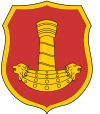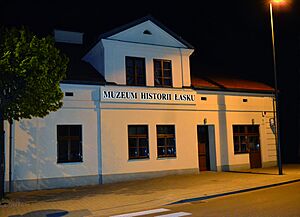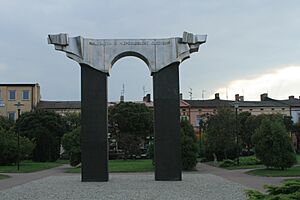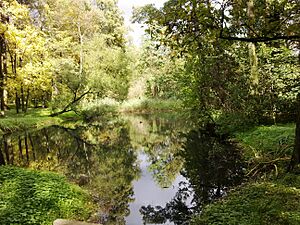Łask facts for kids
Quick facts for kids
Łask
|
||
|---|---|---|
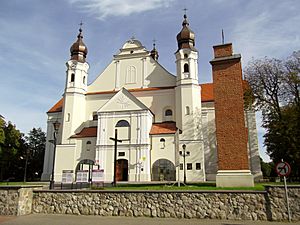
Collegiate Church of the Immaculate Conception of the Blessed Virgin Mary and Archangel Michael
|
||
|
||
| Country | ||
| Voivodeship | Łódź | |
| County | Łask | |
| Gmina | Łask | |
| Established | 11th century | |
| First mentioned | 1356 | |
| Town rights | 1422 | |
| Area | ||
| • Total | 15.33 km2 (5.92 sq mi) | |
| Population
(31 December 2020)
|
||
| • Total | 16,925 |
|
| Time zone | UTC+1 (CET) | |
| • Summer (DST) | UTC+2 (CEST) | |
| Postal code |
98-100
|
|
| Vehicle registration | ELA | |
| Primary airport | Łódź Władysław Reymont Airport | |
Łask ([wask]) is a town in central Poland. About 16,925 people lived there in 2020. It is the main town of Łask County and is located in the Łódź Voivodeship. The Polish Air Force has an important air base nearby. Łask is part of a historical region called Sieradz Land.
Contents
History of Łask

Łask was first settled way back in the 11th century. From the 1300s, it became the home of the powerful Łaski family. They were a noble family, meaning they had a special high status. Their family symbol, the Korab coat of arms, is still the town's symbol today.
The town was first written about in 1356. A church was built in 1366. Later, in 1498, a Polish prince named Frederick Jagiellon started a hospital for people who were poor.
Becoming a Town
In 1422, Łask was officially given "town rights" by Polish King Władysław II Jagiełło. This meant it could grow and have its own rules. The king also allowed Łask to hold a yearly fair and a weekly market. These events helped the town's economy.
In 1504, King Alexander Jagiellon gave the town even more special rights. Soon, many different crafts and trades started to grow in Łask. Between 1517 and 1523, a famous Gothic church was built. It was called a collegiate church and was supported by Jan Łaski, who was a very important church leader. Parts of the church were rebuilt in the 1700s in a style called Baroque.
Thanks to another member of the Łaski family, Hieronymus Łaski, the town was allowed to hold four new fairs in 1613. After the Łaski family, other noble families owned the town until Poland was divided by other countries. Łask was a "private town," meaning it was owned by nobles, not the king.
Jewish people started living in Łask in the late 1500s. For a long time, they made up about half or even more of the town's population. They worked in industries like leather making, textiles (cloth), and food production. Some common last names like Łaski (Laski) and Lasker come from the town's name.
Changes and Challenges
In 1793, Łask became part of Prussia after Poland was divided. Later, it was part of a short-lived Polish state called the Duchy of Warsaw (1807). By 1815, it became part of Congress Poland, which was controlled by Russia. People in Łask took part in Polish uprisings to gain independence in the 1800s. Many Jewish people also moved to Łask during this time, escaping unfair treatment in Russia.
In 1903, a railway line reached Łask, and new factories were built. During World War I, German forces occupied the town. After the war, in 1918, Poland became independent again, and Łask was part of it. By 1939, about 3,864 Jewish people lived in Łask, out of a total of 6,000 residents.
World War II in Łask
When World War II started in September 1939, Łask was taken over by Nazi Germany. The Nazis made it part of a new German province. They targeted and harmed both the Jewish people and Polish leaders in the town. Some Poles from Łask were killed in large massacres nearby in December 1939.
In January 1940, reports said that many Jewish citizens of Łask were killed. Their synagogue, a Jewish house of worship, was also destroyed by fire. By December 1940, many Jewish people from Łask were forced to live in a special area called a ghetto.
In 1941, more Jewish people were brought to Łask from other areas. The Germans also destroyed the old Jewish cemetery and used its gravestones to pave sidewalks. On August 24, 1942, the ghetto was closed. Those who were sick were killed. Many others were sent to a church and then to the Łódź Ghetto or to the Chełmno extermination camp, where they were killed. Later, the Germans found and killed any remaining Jewish people hiding in Łask. A special plaque in Łask remembers the 3,517 Jewish people from the town who were killed in August 1942. Only about 20 Jewish people from Łask survived the war.
After the war ended in 1945, Łask became part of the People's Republic of Poland. By 2004, Łask had about 18,948 residents, but no known Jewish inhabitants.
Łask Today
From 1975 to 1998, Łask was part of the Sieradz Voivodeship. Since November 2012, a group of the US Air Force has been stationed permanently at the Łask Air Base.
Notable People from Łask
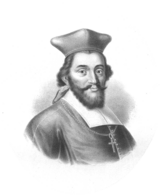
Many interesting people have come from Łask, including:
- Jan Łaski (1456–1531), a very important church leader in Poland.
- Hieronymus Łaski (1496–1542), a Polish diplomat who worked with other countries.
- Jan Łaski (1499–1560), a religious reformer who helped change the Protestant church.
- Olbracht Łaski (died 1604), a Polish alchemist.
- Aaron Karfunkel, a rabbi from the 1700s.
- Mieczysław Wolfke (1883–1947), a Polish physicist.
- Genowefa Kobielska (1906–1993), an athlete who competed in the 1928 Summer Olympics.
- Magda Femme (born 1971), a Polish pop singer.
- Ilona Felicjańska (born 1973), who was crowned Miss Polonia in 1993.
- Dr Luke (born 1973), a famous pop music composer and producer.
- Artur Golański (born 1992), a Polish football player.
Twin Towns
Łask has special friendships with other towns around the world. These are called "twin towns":


